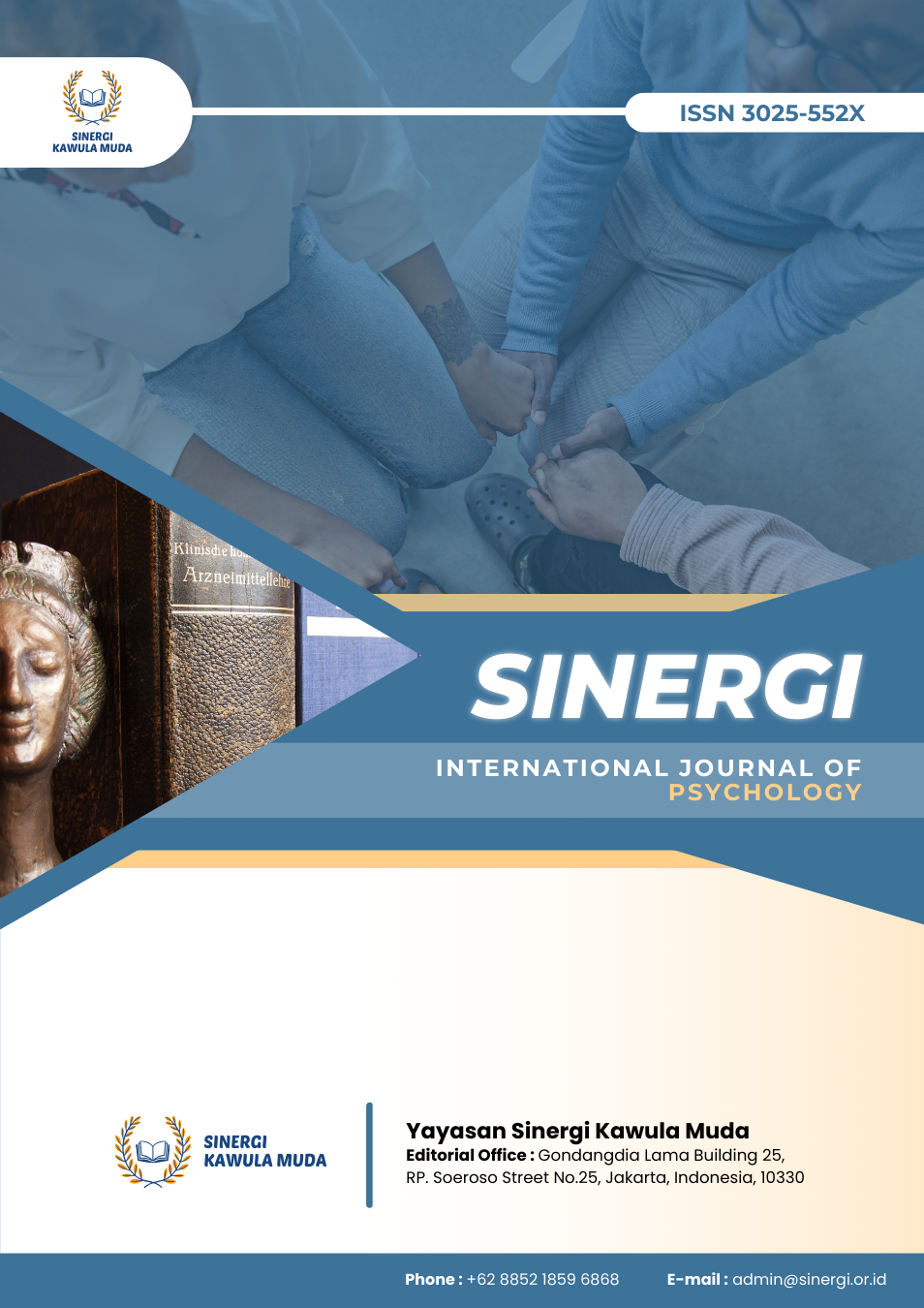Community Resilience and Suicide Prevention: A Review of Policy-Aligned Intervention Strategies
DOI:
https://doi.org/10.61194/psychology.v3i1.698Keywords:
Community-Based Suicide Prevention, Mental Health Literacy, Participatory Interventions, Digital Health Strategies, Public Health Policy, Cross-Cultural Adaptation, Structural Health EquityAbstract
Community-based suicide prevention programs are gaining recognition for their holistic, participatory, and context-sensitive approaches to reducing suicide rates. This narrative review aims to synthesize recent empirical findings on the effectiveness of such interventions, especially in integrating local engagement, educational and religious institutions, sociocultural strategies, and comparative international practices. Utilizing a structured literature search across Scopus, PubMed, and Google Scholar, relevant peer-reviewed articles were selected and analyzed thematically. The results demonstrate that community-driven programs effectively reduce suicide risks by enhancing early detection, emotional support, and crisis response capacities. Engagement of schools and religious leaders fosters mental health literacy, while cultural adaptation improves acceptance and inclusivity. International comparisons reveal that while developed countries benefit from advanced infrastructure and formal systems, developing nations often succeed through community innovation and resilience. Nevertheless, systemic challenges—such as policy gaps, mental health service disparities, and social stigma—persist across contexts. These findings reaffirm the need for a multisectoral, collaborative framework that integrates policy support, community empowerment, and sustainable funding. Strategic use of digital tools and long-term program evaluation is essential. This review contributes to the growing body of knowledge advocating for community-centric, culturally responsive, and structurally supported suicide prevention models.
References
Allen, J., Wexler, L., & Rasmus, S. (2021). Protective factors as a unifying framework for strength-based intervention and culturally responsive american indian and alaska native suicide prevention. Prevention Science, 23(1), 59-72. https://doi.org/10.1007/s11121-021-01265-0 DOI: https://doi.org/10.1007/s11121-021-01265-0
Atkinson, J., Skinner, A., Hackney, S., Mason, L., Heffernan, M., Currier, D., … & Pirkis, J. (2020). Systems modelling and simulation to inform strategic decision making for suicide prevention in rural new south wales (australia). Australian & New Zealand Journal of Psychiatry, 54(9), 892-901. https://doi.org/10.1177/0004867420932639 DOI: https://doi.org/10.1177/0004867420932639
Ayer, L., Stevens, C., Reider, E., Sims, B., Colpe, L., & Pearson, J. (2022). Preventing youth suicide: potential “crossover effects” of existing school-based programs. Prevention Science, 24(2), 382-392. https://doi.org/10.1007/s11121-022-01473-2 DOI: https://doi.org/10.1007/s11121-022-01473-2
Baker, S., Nicholas, J., Shand, F., Green, R., & Christensen, H. (2017). A comparison of multi-component systems approaches to suicide prevention. Australasian Psychiatry, 26(2), 128-131. https://doi.org/10.1177/1039856217743888 DOI: https://doi.org/10.1177/1039856217743888
Barlow, A., Haroz, E., O’Keefe, V., Brockie, T., Manson, S., Allen, J., … & Cwik, M. (2023). New collaborative research on suicide prevention, practice, and policy with american indian and alaska native communities holds promise for all peoples. Health Promotion Practice, 24(5), 841-851. https://doi.org/10.1177/15248399221116630 DOI: https://doi.org/10.1177/15248399221116630
Beehler, S., LoFaro, C., Kreisel, C., Holliman, B., & Mohatt, N. (2021). Veteran peer suicide prevention: a community‐based peer prevention model. Suicide and Life-Threatening Behavior, 51(2), 358-367. https://doi.org/10.1111/sltb.12712 DOI: https://doi.org/10.1111/sltb.12712
Caine, E., Reed, J., Hindman, J., & Quinlan, K. (2017). Comprehensive, integrated approaches to suicide prevention: practical guidance. Injury Prevention, 24(Suppl 1), i38-i45. https://doi.org/10.1136/injuryprev-2017-042366 DOI: https://doi.org/10.1136/injuryprev-2017-042366
Chartier, M., Phanlouvong, A., Weenusk, J., McCulloch, S., Ly, G., Boyd, L., … & Sareen, J. (2022). Evaluating the strengths and challenges of pax dream makers approach to mental health promotion: perspectives of youth and community members in indigenous communities in manitoba, canada. International Journal of Circumpolar Health, 81(1). https://doi.org/10.1080/22423982.2022.2089378 DOI: https://doi.org/10.1080/22423982.2022.2089378
Cox, A., Dudgeon, P., Holland, C., Kelly, K., Scrine, C., & Walker, R. (2014). Using participatory action research to prevent suicide in aboriginal and torres strait islander communities. Australian Journal of Primary Health, 20(4), 345. https://doi.org/10.1071/py14043 DOI: https://doi.org/10.1071/PY14043
Ellis, L., Zurynski, Y., Long, J., Clay‐Williams, R., Ree, E., Sarkies, M., … & Braithwaite, J. (2023). Systems resilience in the implementation of a large-scale suicide prevention intervention: a qualitative study using a multilevel theoretical approach. BMC Health Services Research, 23(1). https://doi.org/10.1186/s12913-023-09769-x DOI: https://doi.org/10.1186/s12913-023-09769-x
Grattidge, L., Hoang, H., Mond, J., Lees, D., Visentin, D., & Auckland, S. (2023). Exploring community-based suicide prevention in the context of rural australia: a qualitative study. International Journal of Environmental Research and Public Health, 20(3), 2644. https://doi.org/10.3390/ijerph20032644 DOI: https://doi.org/10.3390/ijerph20032644
Grattidge, L., Purton, T., Auckland, S., Lees, D., & Mond, J. (2022). Stakeholder insights into implementing a systems-based suicide prevention program in regional and rural tasmanian communities. BMC Public Health, 22(1). https://doi.org/10.1186/s12889-022-14721-5 DOI: https://doi.org/10.1186/s12889-022-14721-5
Hanlon, C., Chopra, J., Boland, J., McIlroy, D., Poole, H., & Saini, P. (2022). James’ place model: application of a novel clinical, community-based intervention for the prevention of suicide among men. Journal of Public Mental Health, 21(1), 82-92. https://doi.org/10.1108/jpmh-09-2021-0123 DOI: https://doi.org/10.1108/JPMH-09-2021-0123
Kearney, L., Smith, C., & Miller, M. (2020). Critical foundations for implementing the va’s public health approach to suicide prevention. Psychiatric Services, 71(12), 1306-1307. https://doi.org/10.1176/appi.ps.202000190 DOI: https://doi.org/10.1176/appi.ps.202000190
Kegler, S., Stone, D., & Holland, K. (2017). Trends in suicide by level of urbanization — united states, 1999–2015. MMWR Morbidity and Mortality Weekly Report, 66(10), 270-273. https://doi.org/10.15585/mmwr.mm6610a2 DOI: https://doi.org/10.15585/mmwr.mm6610a2
Kuosmanen, T., Clarke, A., & Barry, M. (2019). Promoting adolescents’ mental health and wellbeing: evidence synthesis. Journal of Public Mental Health, 18(1), 73-83. https://doi.org/10.1108/jpmh-07-2018-0036 DOI: https://doi.org/10.1108/JPMH-07-2018-0036
Mensa‐Kwao, A., Cuc, I., Concepcion, T., Kemp, C., Hughsam, M., Sinha, M., … & Collins, P. (2024). A mixed methods analysis of youth mental health intervention feasibility and acceptability in a north american city: perspectives from seattle, washington. Plos One, 19(3), e0288214. https://doi.org/10.1371/journal.pone.0288214 DOI: https://doi.org/10.1371/journal.pone.0288214
Mohatt, N., Billera, M., Demers, N., Monteith, L., & Bahraini, N. (2018). A menu of options: resources for preventing veteran suicide in rural communities.. Psychological Services, 15(3), 262-269. https://doi.org/10.1037/ser0000203 DOI: https://doi.org/10.1037/ser0000203
Morgan, A., Roberts, R., Mackinnon, A., & Reifels, L. (2022). The effectiveness of an australian community suicide prevention networks program in preventing suicide: a controlled longitudinal study. BMC Public Health, 22(1). https://doi.org/10.1186/s12889-022-14331-1 DOI: https://doi.org/10.1186/s12889-022-14331-1
Nakano, T., Hasegawa, T., & Okada, M. (2021). Analysing the impacts of financial support for regional suicide prevention programmes on suicide mortality caused by major suicide motives in japan using statistical government data. International Journal of Environmental Research and Public Health, 18(7), 3414. https://doi.org/10.3390/ijerph18073414 DOI: https://doi.org/10.3390/ijerph18073414
O’Keefe, V., Tucker, R., Cole, A., Hollingsworth, D., & Wingate, L. (2018). Understanding indigenous suicide through a theoretical lens: a review of general, culturally-based, and indigenous frameworks. Transcultural Psychiatry, 55(6), 775-799. https://doi.org/10.1177/1363461518778937 DOI: https://doi.org/10.1177/1363461518778937
Okolie, C., Dennis, M., Thomas, E., & John, A. (2017). A systematic review of interventions to prevent suicidal behaviors and reduce suicidal ideation in older people. International Psychogeriatrics, 29(11), 1801-1824. https://doi.org/10.1017/s1041610217001430 DOI: https://doi.org/10.1017/S1041610217001430
Ongeri, L., Wahome, M., Kariuki, S., Bitta, M., Schubart, C., Penninx, B., … & Tijdink, J. (2023). Perspectives on reasons for suicidal behaviour and recommendations for suicide prevention in kenya: qualitative study. Bjpsych Open, 9(2). https://doi.org/10.1192/bjo.2023.7 DOI: https://doi.org/10.1192/bjo.2023.7
Page, A., Atkinson, J., Heffernan, M., McDonnell, G., & Hickie, I. (2017). A decision-support tool to inform australian strategies for preventing suicide and suicidal behaviour. Public Health Research & Practice, 27(2). https://doi.org/10.17061/phrp2721717 DOI: https://doi.org/10.17061/phrp2721717
Powell, N., Dalton, H., Perkins, D., Considine, R., Hughes, S., Osborne, S., … & Buss, R. (2019). Our healthy clarence: a community-driven wellbeing initiative. International Journal of Environmental Research and Public Health, 16(19), 3691. https://doi.org/10.3390/ijerph16193691 DOI: https://doi.org/10.3390/ijerph16193691
Reccord, C., Power, N., Hatfield, K., Karaivanov, Y., Mulay, S., Wilson, M., … & Pollock, N. (2021). Rural–urban differences in suicide mortality: an observational study in newfoundland and labrador, canada: différences de la mortalité par suicide en milieu rural-urbain: une étude observationnelle à terre-neuve et labrador, canada. The Canadian Journal of Psychiatry, 66(10), 918-928. https://doi.org/10.1177/0706743721990315 DOI: https://doi.org/10.1177/0706743721990315
Renaud, J., MacNeil, S., Vijayakumar, L., Spodenkiewicz, M., Daniels, S., Brent, D., … & Turecki, G. (2022). Suicidal ideation and behavior in youth in low- and middle-income countries: a brief review of risk factors and implications for prevention. Frontiers in Psychiatry, 13. https://doi.org/10.3389/fpsyt.2022.1044354 DOI: https://doi.org/10.3389/fpsyt.2022.1044354
Rheinberger, D., Shand, F., Mok, K., McGillivray, L., Maple, M., Burnett, A., … & Torok, M. (2021). A qualitative analysis of motivators to participation in suicide-focused research from a community-based australian sample. International Journal of Environmental Research and Public Health, 18(9), 4705. https://doi.org/10.3390/ijerph18094705 DOI: https://doi.org/10.3390/ijerph18094705
Robinson, G., Leckning, B., Midford, R., Harper, H., Silburn, S., Gannaway, J., … & Hayes, C. (2016). Developing a school-based preventive life skills program for youth in a remote indigenous community in north australia. Health Education, 116(5), 510-523. https://doi.org/10.1108/he-09-2015-0026 DOI: https://doi.org/10.1108/HE-09-2015-0026
Robinson, G., Lee, E., Silburn, S., Nagel, P., Leckning, B., & Midford, R. (2020). School-based prevention in very remote settings: a feasibility trial of methods and measures for the evaluation of a social emotional learning program for indigenous students in remote northern australia. Frontiers in Public Health, 8. https://doi.org/10.3389/fpubh.2020.552878 DOI: https://doi.org/10.3389/fpubh.2020.552878
Robinson, J., Bailey, E., Witt, K., Stefanac, N., Milner, A., Currier, D., … & Hetrick, S. (2018). What works in youth suicide prevention? a systematic review and meta-analysis. Eclinicalmedicine, 4-5, 52-91. https://doi.org/10.1016/j.eclinm.2018.10.004 DOI: https://doi.org/10.1016/j.eclinm.2018.10.004
Scarth, B., Bering, J., Marsh, I., SantiagoIrizarry, V., & Andriessen, K. (2021). Strategies to stay alive: adaptive toolboxes for living well with suicidal behavior. International Journal of Environmental Research and Public Health, 18(15), 8013. https://doi.org/10.3390/ijerph18158013 DOI: https://doi.org/10.3390/ijerph18158013
Sjoblom, E., Ghidei, W., Leslie, M., James, A., Bartel, R., Campbell, S., … & Montesanti, S. (2022). Centering indigenous knowledge in suicide prevention: a critical scoping review. BMC Public Health, 22(1). https://doi.org/10.1186/s12889-022-14580-0 DOI: https://doi.org/10.1186/s12889-022-14580-0
Trout, L., McEachern, D., Mullany, A., White, L., & Wexler, L. (2018). Decoloniality as a framework for indigenous youth suicide prevention pedagogy: promoting community conversations about research to end suicide. American Journal of Community Psychology, 62(3-4), 396-405. https://doi.org/10.1002/ajcp.12293 DOI: https://doi.org/10.1002/ajcp.12293
Turner, K., Stapelberg, N., Svetičič, J., & Dekker, S. (2020). Inconvenient truths in suicide prevention: why a restorative just culture should be implemented alongside a zero suicide framework. Australian & New Zealand Journal of Psychiatry, 54(6), 571-581. https://doi.org/10.1177/0004867420918659 DOI: https://doi.org/10.1177/0004867420918659
Willging, C., Green, A., & Ramos, M. (2016). Implementing school nursing strategies to reduce lgbtq adolescent suicide: a randomized cluster trial study protocol. Implementation Science, 11(1). https://doi.org/10.1186/s13012-016-0507-2 DOI: https://doi.org/10.1186/s13012-016-0507-2
Wexler, L., McEachern, D., DiFulvio, G., Smith, C., Graham, L., & Dombrowski, K. (2016). Creating a community of practice to prevent suicide through multiple channels: describing the theoretical foundations and structured learning of pc cares. International Quarterly of Community Health Education, 36(2), 115-122. https://doi.org/10.1177/0272684x16630886 DOI: https://doi.org/10.1177/0272684X16630886
Wexler, L., Rataj, S., Ivanich, J., Plavin, J., Mullany, A., Moto, R., … & Dombrowski, K. (2019). Community mobilization for rural suicide prevention: process, learning and behavioral outcomes from promoting community conversations about research to end suicide (pc cares) in northwest alaska. Social Science & Medicine, 232, 398-407. https://doi.org/10.1016/j.socscimed.2019.05.028 DOI: https://doi.org/10.1016/j.socscimed.2019.05.028
Yosep, I., Hikmat, R., Mardhiyah, A., & Hernawaty, T. (2024). A scoping review of digital-based intervention for reducing risk of suicide among adults. Journal of Multidisciplinary Healthcare, Volume 17, 3545-3556. https://doi.org/10.2147/jmdh.s472264 DOI: https://doi.org/10.2147/JMDH.S472264
York, J., Lamis, D., Friedman, L., Berman, A., Joiner, T., McIntosh, J., … & Pearson, J. (2012). A systematic review process to evaluate suicide prevention programs: a sample case of community‐based programs. Journal of Community Psychology, 41(1), 35-51. https://doi.org/10.1002/jcop.21509. DOI: https://doi.org/10.1002/jcop.21509





